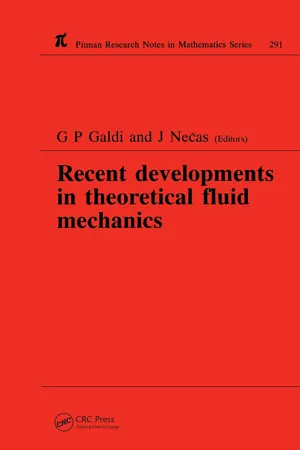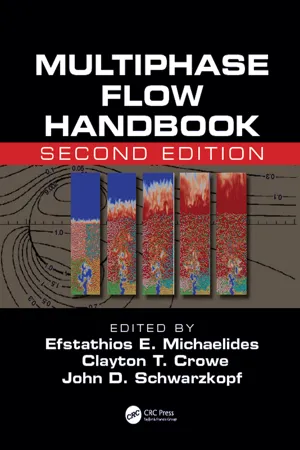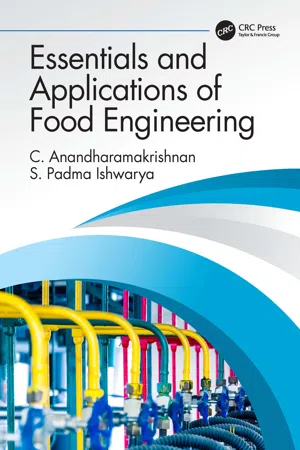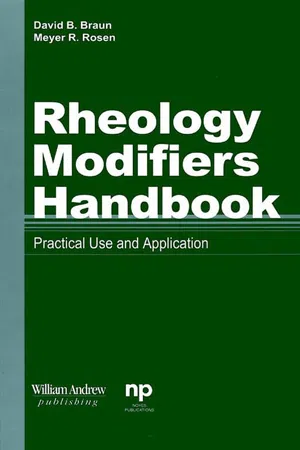Technology & Engineering
Non Newtonian Fluid
A non-Newtonian fluid is a substance that does not follow the typical behavior of Newtonian fluids, such as water or oil, when subjected to stress or shear. Instead, its viscosity and flow properties change in response to applied forces. Examples of non-Newtonian fluids include ketchup, toothpaste, and certain types of industrial fluids, and they are important in various engineering and technological applications.
Written by Perlego with AI-assistance
Related key terms
Related key terms
1 of 4
Related key terms
1 of 3
9 Key excerpts on "Non Newtonian Fluid"
- eBook - ePub
Recent Developments in Theoretical Fluid Mechanics
Winter School, Paseky, 1992
- G P Galdi, J. Necas(Authors)
- 2023(Publication Date)
- Chapman and Hall/CRC(Publisher)
K.R. RajagopalMechanics of Non–Newtonian Fluids
1. Introduction
This series of four lectures is intended to be an introduction to the mechanics of non-Newtonian fluids. It is meant to merely provide a nodding acquaintance to the burgeoning area of non-Newtonian fluid mechanics. The terminology non-Newtonian fluids can apply to a wide range of materials with widely disparate material structure, the main shared characteristic being the inability of the classical linearly viscous Newtonian model to capture the behavior of these fluids. Polymeric liquids, biological fluids, slurries, suspensions, liquid crystals are but some of the materials which belong to the class of non-Newtonian fluids. .The departure from Newtonian behavior manifests itself in these materials in many ways. Here we shall discuss the various features exhibited by non-Newtonian fluids. The main points of deviance from Newtonian behavior are:- The ability to shear thin or shear thicken,
- The ability to creep,
- The ability to relax stresses,
- The presence of normal stress differences in simple shear flows,
- The presence of yield stress.
(i) Shear thinning or shear thickening
Figure 1.Let us first consider a simple shear flow. In the case of a Newtonian fluid, the relation between the shear stress and shear rate is linear. However, in certain fluids this relationship can be non-linear. We could define a generalized apparent viscosity for these materials, which is the ratio of the shear stress to the shear rate. Materials in which the derivative of the generalized viscosity with respect to the shear rate is negative are called shear thinning fluids. If the derivative of the generalized viscosity to the shear rate is positive, such fluids are called shear thickening fluids. There are examples of both kinds of fluids. - eBook - ePub
- Efstathios Michaelides, Clayton T. Crowe, John D. Schwarzkopf, Efstathios Michaelides, Clayton T. Crowe, John D. Schwarzkopf(Authors)
- 2016(Publication Date)
- CRC Press(Publisher)
In contrast, most structured fluids like solutions of high-molecular-weight (>5000 or so) natural (gums and resins) and synthetic polymers and their melts, slurries, pastes, suspensions, foams, emulsions, and surfactant-laden worm-like micellar solutions, for instance, do not conform to the Newtonian postulate and are accordingly known variously as “non-Newtonian,” “rheologically complex,” or “nonlinear” fluids. It is difficult to imagine modern life without such materials. Think of the range of processed foodstuffs we consume every day, personal- and health-care products used routinely, cleaning aids and polishing waxes, etc., all of which fill the aisles of modern supermarkets, for instance.All modern technologies, including modern transportation (in terms of smart materials of construction or advanced fuels), entertainment industry (films, DVDs), medicine, environment, energy generation and conservation, etc., all exploit non-Newtonian characteristics in one form or the other at some stage during the course of their manufacture or application. The extraction of oil from rocks via polymer flooding, the soft gels used to make optical lenses, and the next generation of aviation fuels, all hinge on successfully imparting the desirable rheological characteristics to achieve the satisfactory product quality. Indeed, so widespread is the non-Newtonian fluid behavior that it would be no exaggeration to say that the Newtonian fluid behavior is more of an exception rather than the rule! Consequently, over the past 50–75 years or so, this branch of fluid mechanics has begun to receive systematic attention, albeit it is still in its embryonic stage (Boger and Walters, 1992, Tanner and Walters, 1998, Denn, 2004). Undoubtedly, significant advances have been made in some simple geometries like flow in ducts of circular and noncircular cross sections (Lawal and Mujumdar, 1987, Chhabra, 1999), porous media flows (Chhabra, 1993, 2006, Chhabra et al., 2001), batch mixing vessels (Chhabra, 2003, Paul et al., 2004, Chhabra and Richardson, 2008), etc. In contrast, the corresponding body of knowledge on external flows such as that over a rigid or fluid (bubble or drop) sphere is rather limited. This chapter is concerned with the momentum and heat transfer characteristics of a single rigid (spherical and nonspherical) particle and a fluid sphere (bubble, drop) in different types of confined and unconfined non-Newtonian fluids. The corresponding behavior in a Newtonian fluid is used as the reference line to draw qualitative inferences regarding the influence of non-Newtonian rheology, and therefore, frequent reference will be made to the pertinent sections of Chapter 1 - Tushar Sharma, Krishna Raghav Chaturvedi, Japan Trivedi(Authors)
- 2022(Publication Date)
- Gulf Professional Publishing(Publisher)
Newtonian fluids obey Newton’s law of viscosity and those that do not obey this law are called non-Newtonian fluids. Based on their rheological behavior, they are further subdivided. The rheological characteristics of any fluid can be explained using the shear rate (γ) and shear stress (τ) relationship. The shear stress is the stress generated by a tangential force applied on the fluid. The shear rate is the rate of change of velocity with progressive shearing that takes place between the adjacent layers of fluid. In Newtonian fluids, shear stress is directly proportional to a shear rate, which is a linear relationship that exists between shear stress and shear rate. The proportionality constant, which connects the shear stress and shear rate, is known as viscosity (η). The physical sense of viscosity is the measure of resistance to the flow posed by the adjacent layers because of cohesion. The non-Newtonian flows can be basically categorized as pseudoplastic, dilatant, Bingham, and Bingham plastic. The viscosity of non-Newtonian fluids may vary with shear rate. Fig. 3.1 shows the general classification of fluids with respect to shear stress and shear rate relationship. For the application of nanofluids in any field, their rheological characterization is essential to explain the flow behavior under shear stress (Khodadadi et al., 2018). Fig. 3.1 General classification of fluid behavior (Khodadadi et al., 2018). 3.2: Rheological behavior of nanofluids The rheology of nanofluid comprises the study of its responses to shearing stress and shearing rate and characterizing it as Newtonian or non-Newtonian. It essentially measures the viscosity and viscoelasticity of the nanofluids directly from experiments (basically using a rheometer)- eBook - ePub
Non-Newtonian Flow and Applied Rheology
Engineering Applications
- R. P. Chhabra, J.F. Richardson(Authors)
- 2011(Publication Date)
- Butterworth-Heinemann(Publisher)
Table 1.2 reveals the widespread occurrence of non-Newtonian flow behaviour in materials encountered in everyday life as well as in diverse industrial settings.Table 1.2. Examples of substances exhibiting non-Newtonian fluid behaviour
- Adhesives (wall paper paste, carpet adhesive, for instance)
- Ales (beer, liqueurs, etc.)
- Animal waste slurries from cattle farms
- Biological fluids (blood, synovial fluid, saliva, etc.)
- Bitumen
- Cement paste and slurries
- Chalk slurries
- Chocolates
- Coal slurries
- Cosmetics and personal care products (nail polish, lotions and creams, lipsticks, shampoos, shaving foams and creams, toothpaste, etc.)
- Dairy products and dairy waste streams (cheese, butter, yogurts, fresh cream, whey, for instance)
- Drilling muds
- Fire fighting foams
- Foodstuffs (fruit/vegetable purees and concentrates, sauces, salad dressings, mayonnaise, jams and marmalades, ice-cream, soups, cake mixes and cake toppings, egg white, bread mixes, snacks)
- Greases and lubricating oils
- Mine tailings and mineral suspensions
- Molten lava and magmas
- Paints, polishes and varnishes
- Paper pulp suspensions
- Peat and lignite slurries
- Polymer melts and solutions, reinforced plastics, rubber
- Printing colours and inks
- Pharmaceutical products (creams, foams, suspensions, for instance)
- Sewage sludge
- Wet beach sand
- Waxy crude oils
1.2.2. Non-Newtonian Fluid Behaviour
A non-Newtonian fluid is one whose flow curve (shear stress versus shear rate) is non-linear or does not pass through the origin, i.e. where the apparent viscosity, shear stress divided by shear rate, is not constant at a given temperature and pressure but is dependent on flow conditions such as flow geometry, shear rate, etc. and sometimes even on the kinematic history of the fluid element under consideration. Such materials may be conveniently grouped into three general classes: - eBook - ePub
- C. Anandharamakrishnan, S. Padma Ishwarya(Authors)
- 2019(Publication Date)
- CRC Press(Publisher)
The flow behavior of a fluid is graphically represented by a rheogram, which is the plot between shear stress and shear rate (Figure 4.2). On a rheogram, a Newtonian fluid is represented by a straight line through the origin (Figure 4.2). Water, milk, honey, clear fruit juices, vegetable oil, and dilute solutions of low molecular weight solutes are some well-known examples of Newtonian liquids. In general, liquid foods with more than 90% water content depict Newtonian flow behavior. 4.3.1.1.2 Non-Newtonian Fluids On the other hand, fluids with shear-dependent viscosity are known as non-Newtonian fluids. For non-Newtonian fluids, the relationship between shear stress and shear rate is not linear (Figure 4.2). These are in turn classified as time dependent and time independent, as shown in Figure 4.3. 4.3.1.1.2.1 Time-Independent Non-Newtonian Fluids Time-independent non-Newtonian fluids respond instantaneously to the application of shear stress, indicated by their spontaneous flow. Two major classes of time-independent non-Newtonian fluids are the shear-thinning and the shear-thickening fluids. These fluid types are differentiated by the pattern in which their apparent viscosity changes with the shear rate. Apparent viscosity (μ α) is obtained by approximating the viscosity of a non-Newtonian fluid to a Newtonian fluid. In this approach, a coefficient is calculated from the empirical data considering that the fluid obeys Newton’s law. The calculation of apparent viscosity involves the following steps: A straight line is drawn from the selected point on the curve to the origin at any selected shear rate (Figure 4.4). The apparent viscosity value is obtained from the slope which depends on the selected shear rate - eBook - ePub
Rheology Modifiers Handbook
Practical Use and Applilcation
- David D. Braun, Meyer R. Rosen(Authors)
- 2013(Publication Date)
- William Andrew(Publisher)
While being subjected to steady state shear, a Rheopectic fluid exhibits more resistance to flow with passing time. This behavior is generally associated with aggregation or association as a consequence of shear. Rheopectic behavior is not commonly observed. Such flow behavior has been seen with dilute polymer solutions. (13) In these polymer solutions, Rheopexy is assumed to be caused by reversible cross-link formation (12). Examples of materials which have exhibited unusual Pseudoplastic-Rheopectic behavior are polymeric microcrystalline gels. (14) These systems show viscosity decreases with increasing shear, but viscosity increases with time, at constant shear rate. 7 Characterization of Non Newtonian Flow Mathematical Models and Experimental Methods In dealing with the complexities of non-Newtonian flow, methods are required which allow the description, interpretation, and correlation of flow properties. To this end, a number of mathematical models and techniques have been developed which describe such behavior. In this section, attention is paid to several of these. Despite the trend to develop constitutive theories through the application of continuum mechanics (15), simple models for describing non-Newtonian behavior find many useful applications in industry. (16) Ideally, a simple model for non-Newtonian flow should have four characteristics. (17) It should: 1. Give an accurate fit of the experimental data 2. Have a minimum of independent constants 3. Have constants that are readily evaluated 4. Have constants with some physical basis The constants of such models have been successfully used in many industrial systems to characterize and correlate important responses - eBook - ePub
- F. Holland, R. Bragg(Authors)
- 1995(Publication Date)
- Butterworth-Heinemann(Publisher)
3Flow of incompressible non-Newtonian fluids in pipes
Among other characteristics, non-Newtonian fluids exhibit an apparent viscosity that varies with shear rate. Consequently, the determination of the shear stress–shear rate curve must be an initial consideration. Although the apparent viscosity of a thixotropic or a rheopectic fluid changes with the duration of shearing, meaningful measurements may be made if the change is relatively slow. Viscoelastic fluids also exhibit behaviour that is a function of time but their apparent viscosities can be measured provided conditions of steady shearing are obtained.3.1 Elementary viscometry
There are two main types of viscometer: rotary instruments and tubular, often capillary, viscometers. When dealing with non-Newtonian fluids, it is desirable to use a viscometer that subjects the whole of the sample to the same shear rate and two such devices, the cone and plate viscometer and the narrow gap coaxial cylinders viscometer, will be considered first. With other instruments, which impose a non-uniform shear rate, the proper analysis of the measurements is more complicated.With any viscometer the flow generated should ideally have only one non-zero velocity component, causing shearing in only one direction. The purpose of a viscometer is simultaneously to measure (or control) both the shear stress and the shear rate. Not only must the flow be laminar but viscous forces must be dominant, that is, inertial effects must be negligible.3.3.1 Cone and plate viscometer
A schematic representation of a cone and plate viscometer is shown in Figure 3.1 - eBook - ePub
- Montgomery T. Shaw(Author)
- 2012(Publication Date)
- Wiley(Publisher)
Chapter 5 Generalized Newtonian Fluids—A Small but Important Step Toward a Description of Real Behavior for PolymersOne of the most prominent rheological characteristics of polymer melts or solutions is their non-Newtonian behavior. In most cases, this behavior is pseudoplastic in nature, which means the viscosity decreases with shear rate. The explanation for this behavior is, very roughly, that the velocity gradient tends to stretch out the polymer chains, which allows them to flow more freely past each other. Viscosities can decrease by orders of magnitude over a readily achievable shear-rate range, which is of huge practical importance. Thus, it is important to account for this behavior if realistic predictions are to be expected.In this chapter, the fact that most non-Newtonian polymer fluids also exhibit elastic response (normal stresses) will be summarily ignored. Thus the application of the generalized Newtonian fluid (GNF) expressions should be confined to flows involving primarily steady shear, and where information about orientation is not needed. Any changes in deformation rates along the direction of flow must be very gradual for GNF descriptions to provide a reasonable estimate of the state of stress and the consequent pressure changes.A. REASONS FOR INVENTING GENERALIZED NEWTONIAN FLUIDS—BEHAVIOR OF POLYMER MELTSAs pointed out above, most single-phase polymer melts and solutions tend to exhibit pseudoplastic behavior. Where does this term come from? Its origin clearly has something to do with plastic behavior, so let’s compare these two by examining schematic flow curves for various materials. A flow curve is generally depicted as a graph of shear stress vs. shear rate, using either linear or log scales. Each type of scale has advantages.Figure 5-1 shows schematic flow curves for Newtonian, plastic, pseudoplastic and shear-thickening fluids. The origin of pseudoplastic should thus be clear; it tends to soften the behavior of the strictly plastic response. Proper plastic materials feature a yield stress - eBook - ePub
- Ronald L. Panton(Author)
- 2024(Publication Date)
- Wiley(Publisher)
two-phase-flow problem. There is no well-defined particle size above which mixtures should cease to be considered as uniform fluids and be treated as a two-phase system.Fluids may be non-Newtonian in several ways. The most common departures from Newtonian behavior are (1) the stress is a nonlinear function of the strain, (2) additional normal viscous stresses are produced by shearing, (3) the fluid is elastic as well as viscous, and (4) a finite response time to stress changes. Some fluids show only one of these effects, and others all of them.Figure 6.2 is a sketch of stress versus rate of strain for a simple shearing motion. Newtonian fluids produce a straight line on this graph, and the slope is the viscosity. A fluid is said to be shear thinning if the apparent viscosity decreases with increasing strain rate. This behavior is characteristic of polymers. The most extreme case is a substance that has infinite viscosity, acting like a solid, until a certain level of stress is exceeded. Then the material becomes fluid with a Newtonian characteristic. A model of this behavior, called the Binghman plastic, gives the shear stress as(6.19)Shear stress as a function of strain rate for fluids with various viscous characteristics.Figure 6.2Regions of the flow wherebehave as a solid.Consider a Bingham plastic flows in a tube. A pressure gradient drives the fluid against a retarding shear stress. The shear stress is highest at the wall dropping to zero at the centerline. There is a core of fluid in the middle that moves as a solid plug. In this region the shear is less thanwhile next to the wall the stress is larger thanand the material flows as a fluid. Very concentrated slurries, those with a high volume of particle material, display this characteristic.Fluids that exhibit a normal stress upon shearing give rise to many unusual and interesting flow phenomena. In most normal-stress fluids a shear flow also results in a viscous tension stress along the streamline. Such fluids display the Weisenberg effect
Index pages curate the most relevant extracts from our library of academic textbooks. They’ve been created using an in-house natural language model (NLM), each adding context and meaning to key research topics.
Explore more topic indexes
Explore more topic indexes
1 of 6
Explore more topic indexes
1 of 4








